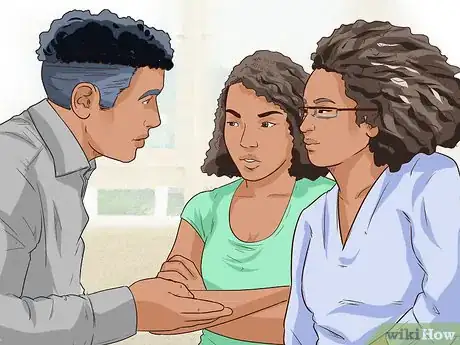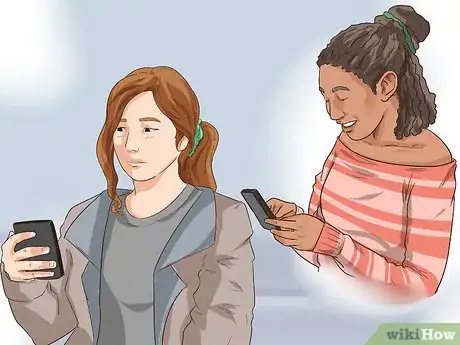This article was co-authored by Crista Beck. Crista Beck is a Dating and Relationship Coach and Matchmaker. With over a decade of experience, she specializes in helping people become open to love and find a partner. Crista has been featured in numerous media sources such as ABC, NBC, Fox, and TEDx. She is also the author of the book, Break The Glass Slipper: Free Yourself from Fairy Tale Fantasies and Find True Love in Real Life. Crista holds a BS in Communication Studies with a focus on Interpersonal Communication from The University of Texas at Austin.
This article has been viewed 124,906 times.
A good wingwoman knows how to highlight her friend’s best qualities to get them talking with some new interesting new people in social settings. Whether you’re at a bar or hanging out casually with friends, you can be a great wingwoman by knowing what your friend wants, being a great conversationalist, and knowing when to leave.
Steps
Supporting Your Friend
-
1Wait for them to ask you. It might be hurtful to your friend if you suggest that you could be their wingwoman, because they might feel criticized for their social skills. They also might not be in the right mood or mindset to meet new potential romantic partners. Therefore, you should wait for your friend to ask you to be their wingwoman.[1]
-
2Talk with your friend about what they want. Ask your friend about what kind of person they’re interested in romantically. You can only tell so much about a person by looking at them and talking to them for a few minutes, so take their preferences with a grain of salt. Here are some traits you can ask about:
- Height
- Hair color
- Eye color
- Profession
- Sense of humor
- Depth of conversation
- Sense of style
Advertisement -
3Scan the crowd with your friend for potential people. While you and your friend are getting drinks or putting your coats away, subtly look around to see people you might want to talk to. Look for people who are friendly, engaged, and open to conversation.
- If it’s just the two of you, look for a smaller group of people (2 or 3) talking in a group.
Guiding the Conversation
-
1Engage a person or group of people in a conversation. Go up to a group of people and start a conversation. Try not to be self-conscious; stand up straight, speak clearly, and introduce yourself. Let your friend introduce himself or herself, too.[2]
- You could try saying something like, “What did you guys order? We’re still deciding!”
- Or, “How do you guys know the host? We were in her sorority in college!”
- A wingwoman should be a great conversationalist as well as a great listener.[3]
-
2Make it clear that you and your friend are not dating, if applicable. Misunderstandings are common, especially with people you’ve just met, so make it clear that you are your friend aren’t together. If it’s easier, you can even mention that you’re taken by someone else.
- For example, if someone asks if you’re dating, you could say, “Well, I’m taken by someone else, but my friend here is still single!”
- Or, you could slyly slip your significant other into the conversation: “My boyfriend doesn’t like this bar, but Joe here knows that they have the best craft beer!”
-
3Steer the conversation towards something that your friend likes. When you’re talking to the person you want your friend to meet, steer the conversation in a direction where you know your friend can contribute. Talk to the person for a few minutes to get a sense of what they’re like. Do you think your friend would like them? Do they have a lot to talk about?
- For example, if the person you're talking to loves water sports, you could say something like, "Oh, no way! My friend Mary loves to water ski."
- You could also say something like, "Oh, you're a Red Sox fan? So is Sue! We just went to a game the other weekend."
- Try to match and blend into the ongoing conversation.[4]
-
4Bring your friend away from the person, if necessary. If they don’t have a lot to talk about, or if you get a weird vibe from the person, take your friend to use the restroom or to get another drink. There’s no point in introducing them if you don’t think they would get along.
-
5Introduce your friend to the person you found for them. Draw your friend and the person closer together in conversation. If you’ve steered the conversation towards travel, ask the person about where he’s travelled and then mention your friend’s recent travels.
- Make the conversation about your friend, not you. You should be able to fade into the background of the conversation and let them keep talking.[5]
- You should think of a couple really funny stories beforehand that paint your friend in a good light. If the conversation becomes relevant, bring these stories up to talk up your friend.[6]
Having an Escape Plan
-
1Have a distress signal. Figure out with your friend beforehand a distress signal that you each can use to get out of a boring or uncomfortable situation. It could be a word or a gesture. Here are some suggestions:[7]
- Tugging your earlobe
- A word you wouldn’t use otherwise in conversation
- Winking
-
2Leave the conversation. If your friend seems like they're having fun, let them know that you’re going to leave. If they give you a stressed look or your sign of distress, don’t go. But, if they tell you they're having a good time and seem as though they would be okay without you, then leave the conversation. You can chat up other people in the group, use the restroom, or go find someone else to talk to.[8]
-
3Determine if you should return. Don’t ditch your friend with this new person. Gauge the situation to see if they want to be left alone, or if your friend wants you to come back to rescue them. You can shoot them a quick text, or make eye contact with them from across the room. Either way, don’t abandon your friend for the night without checking in with them first.[9]
References
- ↑ http://www.hercampus.com/love/dating/7-tips-being-best-wingwoman-ever
- ↑ http://www.thedatereport.com/dating/advice/1112-how-to-be-a-perfect-wingwoman-for-other-women/
- ↑ Crista Beck. Dating Coach & Matchmaker. Expert Interview. 26 August 2021.
- ↑ Crista Beck. Dating Coach & Matchmaker. Expert Interview. 26 August 2021.
- ↑ http://www.hercampus.com/love/dating/7-tips-being-best-wingwoman-ever
- ↑ http://www.seventeen.com/love/dating-advice/advice/g75/wing-woman-tips/?slide=8
- ↑ http://www.seventeen.com/love/dating-advice/advice/g75/wing-woman-tips/?slide=2
- ↑ http://www.thedatereport.com/dating/advice/1112-how-to-be-a-perfect-wingwoman-for-other-women/
- ↑ http://www.thedatereport.com/dating/advice/1112-how-to-be-a-perfect-wingwoman-for-other-women/














-Step-29-Version-5.webp)
